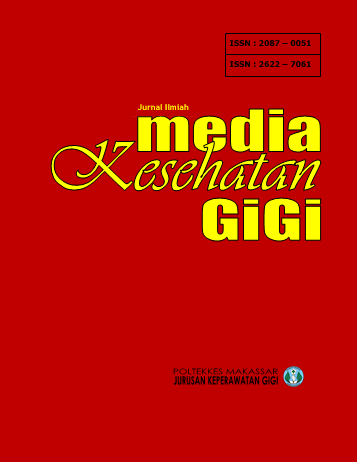The Effectiveness of Snakes and Ladders as an Additional Educational Media for Changing Students’ Dental Health Behaviour
DOI:
https://doi.org/10.32382/mkg.v24i1.1468Keywords:
Snake Ladder, Powerpoint, Students' Dental Health BehaviorAbstract
Providing education in health promotion aims to maintain oral health by focusing on efforts to modify or eliminate the factors that cause it (Gavic, et al., 2021). Health education aims not only to increase literacy related to oral health, but to bring about positive behavioral changes if instilled from an early age (Kay, 1996 cited. Deokar, et al., 2021).The purpose of this study was to determine the impact of the Snakes and Ladders game on the behavior of fourth grade students after dental health education with PowerPoint media. This study is included in the type of quasi-experiment with a pretest-posttest research design involving a control group. This study involved 100 respondents who were divided into two groups. The intervention group consisted of 50 fourth grade students of MIN 3 Bireuen who received education using PowerPoint media accompanied by a Snakes and Ladders game. While the control group consisted of 26 fourth grade students of MIN 9 and 24 students of MIN 19 who were only given education with PowerPoint media. Each study group received health education 4 times, and behavior-related questionnaires were administered at pretest and posttest I (1 month), and posttest II (3 months). Results: there was a significant difference in behavior in the intervention group (0.014) from pretest to posttest II, but the difference in behavior difference from pretest to posttest in both groups did not show a significant value (0.173). Conclusion: snakes and ladders game given after education with PowerPoint media is not better in improving students' dental health behavior.
Keywords : Snake Ladder; Powerpoint; Students' Dental Health Behavior
Downloads
Published
How to Cite
Issue
Section
License
Copyright (c) 2025 Hayatunnufus

This work is licensed under a Creative Commons Attribution-ShareAlike 4.0 International License.
The authors retain copyright and grant Media Kesehatan Gigi journal the right of first publication with the work simultaneously licensed under a Creative Commons Attribution-ShareAlike 4.0 International License, which allows others to share the work with an acknowledgment of the work's authorship and initial publication in this journal.
.pdf (Bahasa Indonesia) downloaded: 88






